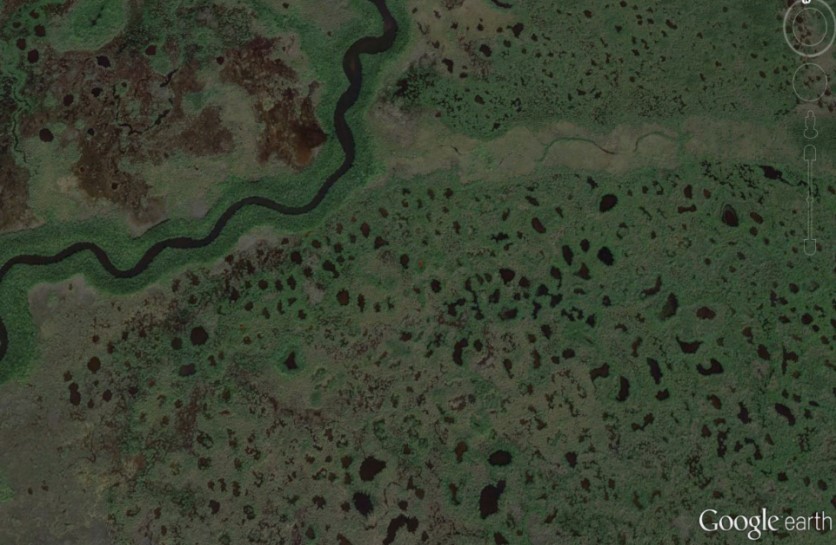Case Study 2.2: The Everglades: Changing Hydrology
This case study will consider the challenges faced by one of the world’s truly unique ecosystems: the Florida Everglades. These extensive subtropical wetlands are unlike any other in the world. Yet human activities, primarily water management programs and extensive agricultural and urban development nearby, have diverted freshwater flow away from the Everglades, changing both the quantity of water and the quality of the ecosystem. Currently one of the largest restoration projects in the world is attempting to increase water flow to and improve conditions in this unique ecosystem.
As we consider the condition of today’s Everglades, we’ll focus on three aspects: (1) historic changes in the hydrology of the Everglades and the implications of these changes for the ecosystem; (2) the use of indicators to tell us how the Everglades are faring; and (3) efforts to increase freshwater flow to the Everglades.
Before you start, review some of the Background Materials on the Everglades presented here.

Background Materials:
Background on the Everglades: a good site for general information about the Everglades is
http://www.nps.gov/ever/learn/nature/animals.htm maintained by the National Park Service.
http://www.nwf.org/Wildlife/Wild-Places/Everglades.aspx, a site from the National Wildlife Federation, gives some background on the Everglades ecosystem and the threats it faces.
The US Geological Survey takes a look at how human actions have altered the Everglades at
http://pubs.usgs.gov/circ/circ1182/pdf/12Everglades.pdf.
Everglades Flora and Fauna: to see a complete listing for the plants and animals of the Everglades, visit https://www.nps.gov/ever/learn/nature/animals.htm. Click on any species name to view a thumbnail sketch of that creature.
Water Management in the Everglades: F.T. Izuno presents a brief history of water management in the Everglades at http://edis.ifas.ufl.edu/pdffiles/AE/AE37500.pdf
Everglades Restoration: for a broad overview of the restoration that includes a good summary of the history of the effort, water management issues and the like, visit the South Florida Everglades Project at http://www.ce.utexas.edu/prof/maidment/grad/dugger/GLADES/glades.html#Restoration .
To view the Annual Report of the Comprehensive Everglades Restoration Plan (CERP), go to http://www.sfwmd.gov/portal/page/portal/pg_grp_sfwmd_sfer/portlet_prevreport/2015_sfer_final/v1/appendices/v1_app1-4.pdf.
To learn more about federal agency monitoring in the Everglades: visit http://sofia.usgs.gov/projects/index.php?project_url=sys_monitor and http://www.sofia.usgs.gov/publications/papers/swdis_salmon/index.html to learn more about the U.S. Geological Survey’s monitoring in the Everglades and what they’re doing in support of efforts to restore the Everglades.
Textbook References and Links:
Exercise 2: The Radarsat-1 sensor operated by the Canadian Space Agency. http://www.asc-csa.gc.ca/eng/satellites/radarsat1/applications.asp
Exercise 3: Access to the article by Herring et al.: Science of the Total Environment (2013) 458-460: 637-646. http://www.sciencedirect.com/science/article/pii/S0048969713004580
Restoring the Everglades basic overview of the CERP plan (video): https://www.youtube.com/watch?v=b2WfLSR-Rqg
Exercise 6: The CERP web site covers the basic steps proposed to help restore the flow of fresh water to the Everglades:http://141.232.10.32/pm/ssr_2014/ssr_main_2014.aspx
Exercise 7: For the most recent CERP System Wide Ecological Status Report on Everglades restoration efforts, go to
http://www.evergladesrestoration.gov/content/system_wide_ecological_indicators.html .
This links to all of the reports but the 2014 report can also be found at https://issuu.com/evergladesrestoration/docs/2014_indicator_report?e=8031892/12097978
Downloadable data and files:
Exercise 1: Everglades Data.txt. This monthly composite of P-35 monitoring gauge water height dates back to 1962, and it allows us to examine the historical trends in water level at this site.
Exercise 3: Herring 2013.pdf


